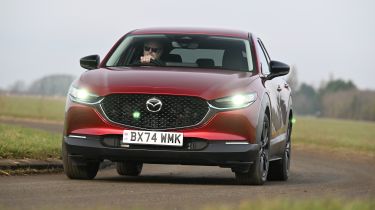Mazda CX-30 review - Engines, drive & performance
“The Mazda CX-30's SUV proportions don't blunt the driving experience”
The Mazda CX-30 is based on the Mazda3 hatchback, a car we've already described as having a great chassis. Happily, the extra height of the CX-30 SUV's roof hasn't affected it too badly either, so it's still fun to drive. The manual gearbox is excellent, and there's a lovely cohesion to the feel of the pedals and steering that makes it intuitive to drive.
Drive along a twisty road and there's just a little body lean, which lets you know when the car is reaching the edge of its comfort zone. The trade-off for the body control is a slightly firm ride over small imperfections, although bigger bumps are soaked up well. Along with the Ford Puma and Cupra Formentor, it's one of the most fun SUVs for keen drivers.
While the old entry-level 2.0-litre engine was the weakest part of the CX-30’s drive, the later 2.5-litre feels like a welcome addition because now it has the extra punch it lacked.
Mazda CX-30 petrol engines
While most cars in this class have 1.0-litre or 1.2-litre engines, the CX-30’s entry-level 2.5-litre e-SkyActiv-G engine looks comparatively huge. Unlike rivals, the CX-30 doesn’t use a turbocharger. The 2.5-litre replaces what used to be a 2.0-litre unit with 121bhp, so power is now increased to 138bhp. Importantly, where the older, smaller version used to feel quite gutless lower down in the rev range, the larger engine gives some extra shove where it’s needed. The entry-level car can do 0-62mph in a brisker 9.7 seconds than the 11.2 seconds from before, and goes on to a top speed of 121mph.
Despite the engine being smaller at 2.0 litres, the e-SkyActiv-X which sits higher up in the range is the more powerful unit. It produces 184bhp, yet is also the more economical of the two. In top-spec Takumi models you can have this version with all-wheel drive, while all other versions are front-wheel drive. The e-SkyActiv model can do the 0-62mph sprint in 8.3 seconds, with a top speed of 127mph – go for all-wheel drive and the 0-62mph time increases to nine seconds. Compared to turbocharged rivals, however, you have to work the CX-30 quite hard and wring it out through the rev range to exploit its full potential, which can take some getting used to.
Both petrol engines are also aided slightly by Mazda's mild-hybrid technology, conserving energy gathered as the car slows down and using it to assist the engine under acceleration. You'll barely detect it working as you drive but the e-SkyActiv-X engine does feel more willing to pick up speed from low revs than the engine it replaces.










